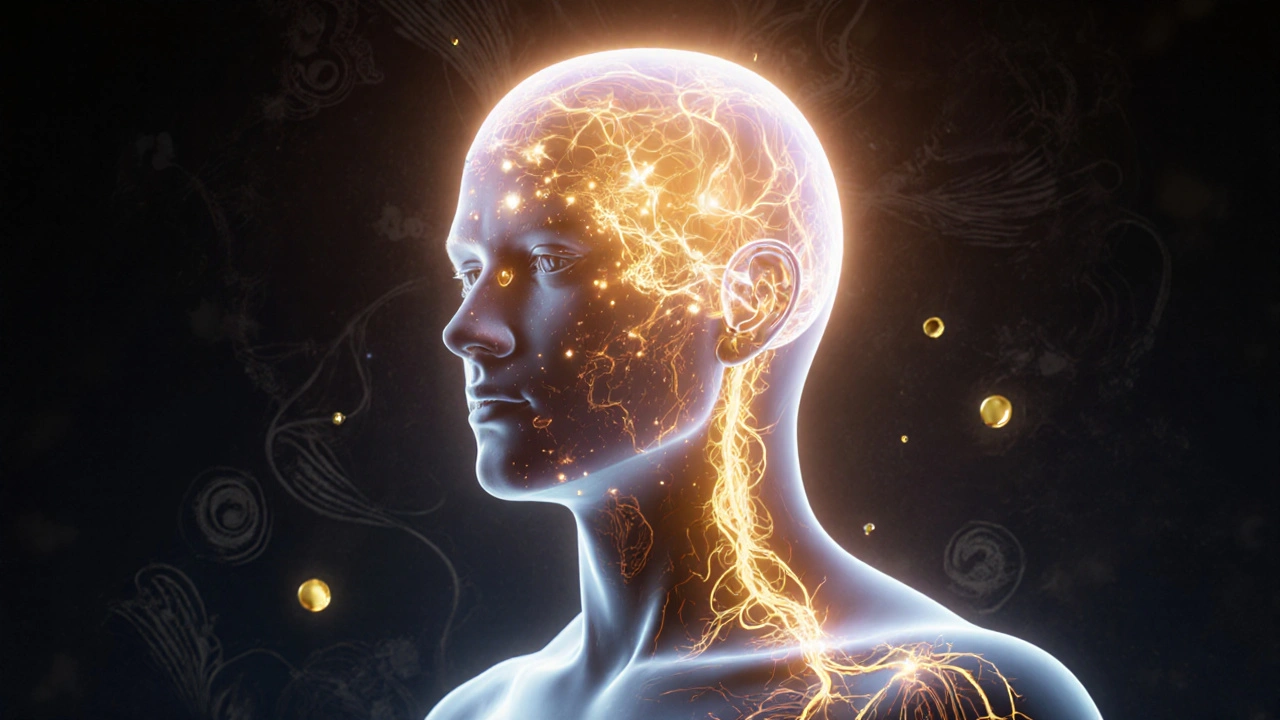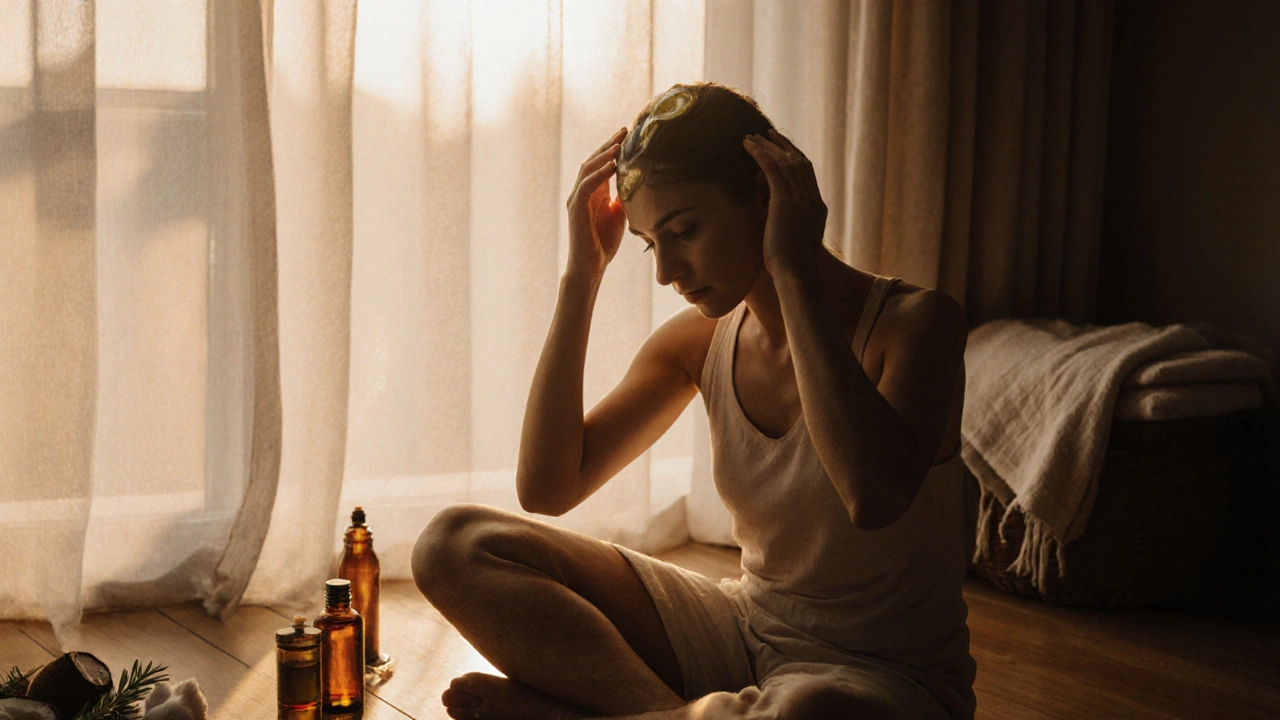Champissage Results Estimator
Predict Your Champissage Results
Based on the article's research, estimate when you might see benefits based on your practice frequency and concerns.
Your Practice Frequency
Your Primary Concerns
Estimated Results Timeline
Select your frequency and concerns to see when you might experience benefits.
Champissage isn’t just a fancy word for a head rub. It’s a 2,000-year-old Indian practice that targets more than just your scalp-it’s designed to release tension, improve circulation, and even help with sleep and focus. If you’ve ever felt that tight band around your forehead after a long day, or noticed your hair thinning despite using every product on the market, champissage might be the missing piece you didn’t know you needed.
What Exactly Is Champissage?
Champissage comes from the Hindi word champna, meaning to press or massage. It’s a form of Indian head massage that focuses on the scalp, neck, shoulders, and upper back. Unlike a typical spa head rub, champissage uses specific techniques to stimulate pressure points along the head’s energy lines, known as marma points in Ayurveda. These points connect to organs, nerves, and emotional centers.
Practitioners use their thumbs, fingers, and palms to apply rhythmic pressure, kneading, and circular motions. The session usually lasts 20 to 45 minutes and is often done with warm herbal oils like coconut, sesame, or almond-each chosen for their therapeutic properties. This isn’t a luxury treatment; it’s a functional tool used daily in rural India to manage stress, headaches, and even insomnia.
Why Your Scalp Matters More Than You Think
Your scalp is packed with over 100,000 hair follicles, 20 major nerves, and hundreds of tiny blood vessels. When tension builds up here-whether from staring at screens, clenching your jaw, or sleeping wrong-it doesn’t just cause a headache. It restricts blood flow to your hair roots, which can slow growth and increase shedding.
A 2023 study published in the Journal of Traditional and Complementary Medicine found that participants who received daily 15-minute scalp massages for six months saw a 28% increase in hair thickness. That’s not because the massage made hair grow faster-it’s because it improved oxygen and nutrient delivery to follicles. The same pressure that relaxes your neck also wakes up dormant hair cells.
And it’s not just about hair. Tension in the scalp triggers the trigeminal nerve, which connects to your eyes, sinuses, and even your digestive system. That’s why people with chronic migraines often report fewer episodes after consistent champissage.
How Champissage Differs From Other Head Massages
Not all head massages are created equal. A quick rub at a salon might feel nice, but it doesn’t deliver the same results. Here’s how champissage stands out:
- Pressure points: Champissage targets 10 key marma points on the head, unlike general massages that just glide over the surface.
- Directional strokes: Movements follow the natural flow of energy, moving from the forehead to the back of the head, not random circles.
- Oil integration: Warm herbal oils are used to enhance absorption and stimulate circulation-this isn’t optional, it’s core to the practice.
- Duration and rhythm: Sessions are structured, not rushed. Each technique is held for 3-5 seconds to allow muscle release.
For example, a Swedish head massage might focus on relaxation through light stroking. Champissage is more like a targeted reset button for your nervous system.

Step-by-Step: How to Do Champissage at Home
You don’t need a license or expensive tools to do champissage. Here’s how to do it right:
- Warm the oil: Heat 2 tablespoons of coconut or sesame oil until it’s just warm to the touch-not hot. Add 2 drops of rosemary or peppermint essential oil if you have headaches.
- Start at the forehead: Place your thumbs just above your eyebrows. Use gentle, circular motions for 30 seconds. This relieves sinus pressure and calms the mind.
- Move to the temples: Use your index and middle fingers to press and hold each temple for 5 seconds, then release. Repeat 5 times. This eases tension headaches.
- Scalp circles: Spread your fingers across your scalp. Make slow, firm circles, starting from the front and moving to the back. Cover every inch. Spend at least 3 minutes here.
- Neck and shoulders: Use your thumbs to knead the base of your skull and the top of your shoulders. Roll the muscles between your fingers for 1 minute.
- Finish with a sweep: Run your palms from your forehead to the back of your head in one smooth motion. Do this 3 times to seal in the energy.
Do this 3-4 times a week. You’ll start noticing less tension in your jaw, better sleep, and reduced hair fall within 2-3 weeks.
The Best Oils for Champissage
Not all oils work the same. Here’s what to use based on your needs:
| Oil | Best For | Key Benefits |
|---|---|---|
| Coconut oil | Dry scalp, hair thinning | Antifungal, deeply moisturizing, reduces protein loss in hair |
| Sesame oil | Stress, poor circulation | Warms the skin, improves blood flow, rich in antioxidants |
| Almond oil | Sensitive skin, brittle hair | High in vitamin E, soothes inflammation, strengthens follicles |
| Jasmine oil (essential) | Anxiety, insomnia | Calms the nervous system, promotes deep relaxation |
| Rosemary oil (essential) | Slow hair growth, dandruff | Stimulates follicles, reduces scalp inflammation |
Never use cold oil. Warmth opens pores and lets the nutrients sink in. Always test a drop on your wrist first-some people react to essential oils.
Who Should Avoid Champissage?
Champissage is safe for most people, but skip it if you have:
- Open wounds, cuts, or infections on your scalp
- Recent head or neck injury
- Severe migraines triggered by pressure
- High blood pressure without doctor approval
- Scalp conditions like psoriasis or eczema in active flare-up
If you’re pregnant, avoid deep pressure on the neck and back of the head. Light strokes are fine, but consult your provider first.

Real Results: What People Experience
One woman in her late 30s started champissage after years of hair thinning and constant tension headaches. She did it daily for 8 weeks, using coconut oil with a drop of rosemary. Her hair loss dropped by 70%. Her headaches went from daily to once a month. She didn’t change her diet, her shampoo, or her sleep schedule-just added this 15-minute ritual.
A teacher in Delhi told researchers he used champissage after every class. He stopped needing painkillers for neck pain. His students noticed he seemed calmer, more present. He didn’t realize he was giving himself a mini-reset.
These aren’t outliers. In Ayurvedic clinics across India, champissage is prescribed as a first-line treatment for stress-related disorders-not as a side note, but as a core therapy.
How to Make Champissage a Habit
Consistency beats intensity. Here’s how to stick with it:
- Do it before bed-it helps you fall asleep faster.
- Pair it with calming music or a guided meditation app.
- Keep your oil bottle next to your toothbrush so you don’t forget.
- Track your progress: note your sleep quality, headache frequency, and hair shedding each week.
Don’t wait for perfect conditions. Even 5 minutes counts. On busy days, just rub your scalp with your fingertips for a minute while brushing your teeth.
What Comes After Champissage?
Once you’ve mastered the basics, you can deepen your practice. Try adding:
- Herbal hair rinses with neem or amla after washing
- Yoga poses like Child’s Pose or Legs-Up-the-Wall to enhance circulation
- Breathwork: inhale for 4 counts, hold for 4, exhale for 6-this syncs with your massage rhythm
Champissage isn’t a quick fix. It’s a lifestyle tool. Used daily, it rewires your body’s response to stress. It’s not just about hair or headaches-it’s about reclaiming calm in a noisy world.
Can champissage regrow hair?
Champissage doesn’t magically regrow hair where follicles are dead, but it can stimulate dormant ones. Studies show it improves thickness and reduces shedding by boosting blood flow and nutrient delivery. For best results, combine it with a healthy diet and avoid harsh chemicals.
How often should I do champissage?
Three to four times a week is ideal for most people. Daily sessions are fine if you’re dealing with stress or hair loss, but listen to your body. If your scalp feels sore, take a day off.
Do I need special oils for champissage?
You don’t need fancy oils, but plain coconut or sesame oil works best. Avoid mineral oil or synthetic products-they clog pores. Essential oils like rosemary or lavender can boost results, but always dilute them in a carrier oil.
Can I do champissage on someone else?
Yes, and it’s a great way to bond. Use the same technique, but ask for feedback on pressure. Many people find giving champissage as relaxing as receiving it.
How long until I see results?
Most people notice less tension and better sleep within 1-2 weeks. Hair shedding decreases after 3-4 weeks. Thickness improvements show up around the 8-week mark. Patience is key.
Champissage is simple, cheap, and deeply effective. You don’t need a spa. You don’t need a degree. Just your hands, some warm oil, and 15 minutes a day. That’s all it takes to reset your nervous system, support your hair, and quiet the noise in your head.


 Health and Wellness
Health and Wellness